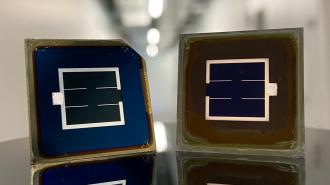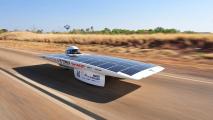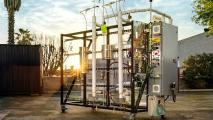Swiss team sets new world record for solar power
Swiss researchers have done the (theoretically) impossible, creating not one but two silicon-based solar cells with efficiencies greater than 30% — breaking a world record and potentially illuminating the path to a future of cheaper clean energy.
The status quo: Solar cells absorb light and convert it into electricity. They’re the basis of most solar power tech, and about 95% of them are made from silicon because it’s abundant, long-lasting, and relatively cheap.
Most of the silicon solar cells sold today are about 22% efficient, meaning they convert 22% of the solar energy that hits them into electricity. We don’t have too much room for improvement with silicon solar cells, either, as they have a theoretical efficiency limit of about 29%.
“[More efficient] devices are a thousand times more expensive than silicon solar cells.”
Christophe Ballif
The challenge: If we could increase the efficiency of solar cells without dramatically increasing production costs, we could generate the same amount of electricity with fewer solar panels, saving on space and lowering the price of solar power.
Solar cells have broken the 30% limit — one has even reached 47% in the lab — but those were made from materials that are impractical for widespread use.
“[The] materials and the processes used to make them are too expensive to sustain the energy transition,” said Christophe Ballif, head of EPFL’s Photovoltaics Laboratory and CSEM’s Sustainable Energy Center. “These devices are a thousand times more expensive than silicon solar cells.”
Team effort: EPFL and CSEM researchers have now broken the theoretical efficiency limit of silicon with two different solar cells, reaching an efficiency of 30.93% with one and 31.25% with the other.
Both are “tandem solar cells,” meaning they combine two different materials into a single cell — in this case, silicon and the mineral perovskite. For the 30.93% efficient cell, the perovskite was layered on top of a smooth silicon surface. For the other cell, the silicon surface was textured.
“Our results are the first to show that the 30% barrier can be overcome using low-cost materials and processes.”
Christophe Ballif
The key to the team’s success was the development of new material processing and depositing techniques. Once built, the silicon part of the cell absorbed lower-energy infrared light, while the perovskite layer absorbed and converted higher-energy visible light.
“Our results are the first to show that the 30% barrier can be overcome using low-cost materials and processes, which should open new perspectives for the future of [photovoltaics],” said Ballif.
Looking ahead: These new perovskite-on-silicon solar cells are small — just one square centimeter each — so more research will be needed to make sure they can generate electricity as efficiently when scaled up.
If they can, the cells could help spur the adoption of solar power tech throughout the world — accelerating our transition to a future powered solely by clean energy.
We’d love to hear from you! If you have a comment about this article or if you have a tip for a future Freethink story, please email us at [email protected].






